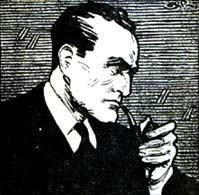Related Research Articles
Monsieur Zenith the Albino is an ambiguous villain created by writer Anthony Skene for the "Sexton Blake" series of detective pulp fiction.

Sexton Blake is a fictional character, a detective who has been featured in many British comic strips, novels and dramatic productions since 1893. Sexton Blake adventures were featured in a wide variety of British and international publications from 1893 to 1978, comprising more than 4,000 stories by some 200 different authors. Blake was also the hero of numerous silent and sound films, radio serials, and a 1960s ITV television series.

Commander Chambré George William Penn Curzon, known as George Curzon, was a Royal Navy commander, actor, and father of the present Earl Howe.

Raymond Lovell was a Canadian actor who performed in British films. He mainly played supporting roles, often somewhat pompous characters.
George King was an English actors' agent, film director, producer and screenplay writer. He is associated with the production of quota quickies. He directed several of Tod Slaughter's melodramas, including 1936's The Demon Barber of Fleet Street.

Ian Fleming was an Australian character actor with credits in over 100 British films. One of his best known roles was playing Dr Watson in a series of Sherlock Holmes films of the 1930s opposite Arthur Wontner's Holmes.
Murder at Covent Garden is a 1932 British crime film directed by Leslie S. Hiscott and starring Dennis Neilson-Terry, Anne Grey, George Curzon and Walter Fitzgerald. It was made at Twickenham Studios. The screenplay involves a detective who investigates the murder of a night club owner.
Michael Barringer was a British writer, screenwriter and playwright. He also occasionally served as film director, directing four films early in his career. His play Inquest was the first performed at the Windmill Theatre when it opened in 1931.
George Mann is a British author and editor, primarily in genre fiction, and is best known for his alternate history detective novel series Newbury and Hobbes (2008-2019) and The Ghosts action science fiction noir novels (2010-2017), a book series set in the same universe.

Wilson Coleman (1873–1940) was a British actor.
Sexton Blake and the Hooded Terror is a 1938 British crime film directed by George King and starring George Curzon, Tod Slaughter and Greta Gynt. It was George Curzon's third and final outing as the fictional detective Sexton Blake.
Alex Bryce (1905–1961) was a British screenwriter, cinematographer and film director.
Sexton Blake and the Bearded Doctor is a 1935 British mystery film directed by George A. Cooper and starring George Curzon, Henry Oscar and Tony Sympson. It is based on the novel The Blazing Launch Murder by Rex Hardinge, and was one of George Curzon's three big screen outings as the fictional detective.

Tony Sympson was a British actor.

Benjamin Percy Williams was a British character actor from the 1930s to the late 1950s. During his career he appeared in 137 films. In 1954 Williams acted in the BBC Radio play Under Milk Wood that won the Prix Italia award for radio drama that year.
Murder at Site 3 is a 1958 British film directed by Francis Searle and starring Barbara Shelley, Geoffrey Toone and John Warwick. featuring the character of Sexton Blake. It was written by Paddy Manning O'Brine, based on the 1958 novel Crime is My Business by W Howard Baker, and produced at Bray Studios by Francis Searle's own production company.
John Seabourne was a British film editor active between the 1930s and 1950s. During the early 1930s he edited British Gaumont's newsreels. He is sometimes known as John Seabourne Sr. to distinguish him from his son.
Peter Saxon is a pen name used by various thriller authors from the 1950s to the 1970s.
Sexton Blake is a 1928 six-part silent film serial produced by British Filmcraft. The serial stars Langhorne Burton as the fictional detective Sexton Blake, and Mickey Brantford as his assistant Tinker.

George Hamilton Teed was a Canadian author who also wrote under the pen-names G. H. Teed, Hamilton Teed, Louis Brittany, Peter Kingsland, and Desmond Reid. Teed was born in Woodstock, New Brunswick. He specialized in adventure fiction and detective stories, but also wrote science fiction and the odd romance. He is best remembered for his tales of Sexton Blake, a popular, fictional British detective who featured in a wide variety of publications in the first half of the twentieth century. He wrote close to three hundred Blake tales, more than any other author, and his creations and writings are considered "the best in Blake history before the Second World War."
References
- ↑ Gifford, Denis (1 April 2016). British Film Catalogue: Two Volume Set – The Fiction Film/The Non-Fiction Film. Routledge. ISBN 9781317740636 – via Google Books.
- ↑ "Sexton Blake and the Mademoiselle (1935)". Archived from the original on 3 August 2012.
- ↑ The Unknown 1930s: An Alternative History of the British Cinema, 1929– 1939, edited by Jeffrey Richards, IB Tauris (1998), p.92
- ↑ "Sexton Blake And The Mademoiselle". TVGuide.com.